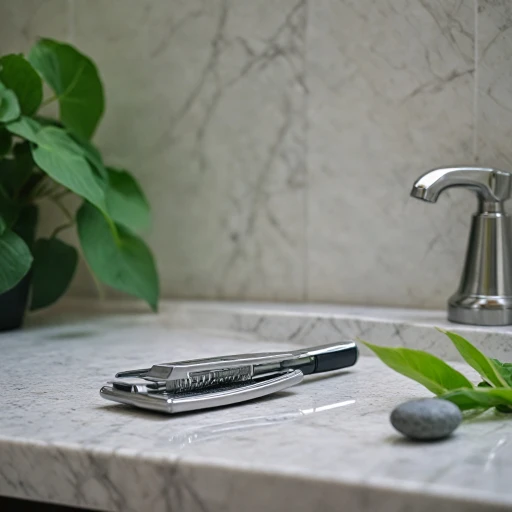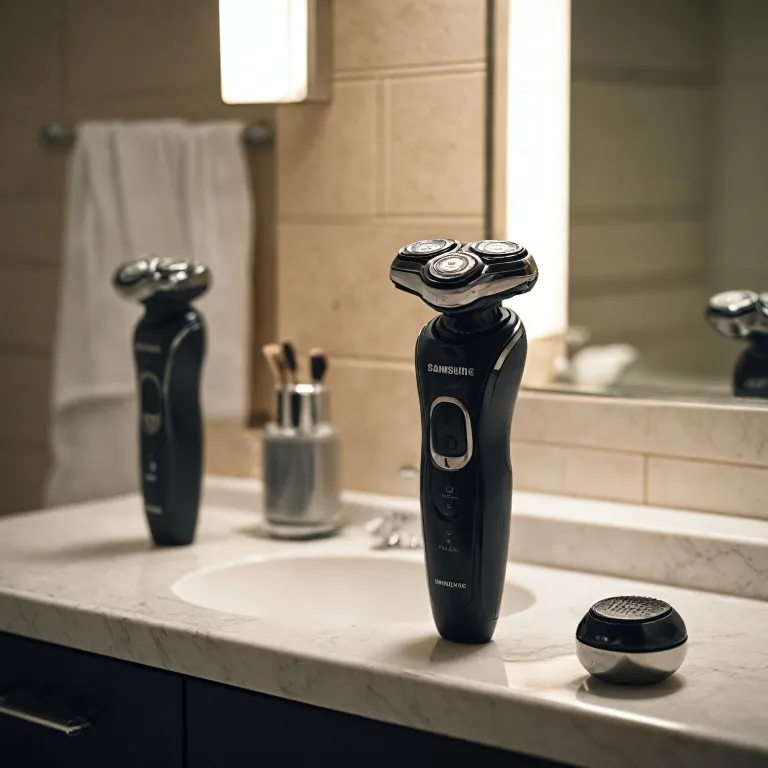Understanding Electric Shavers
Decoding the Magic Behind Electric Shavers
Electric shavers are a staple for many who seek efficient and hassle-free grooming. The world of electric razors can be transformative if you understand what makes them tick. Unlike their manual counterparts—razors that demand precision and patience—electric shavers offer speed and convenience without sacrificing quality.
Design VariationsThere are primarily two types of electric shavers: rotary and foil. Each has unique attributes that cater to different shaving needs. Foil shavers employ a thin metal foil to trap hair with oscillating blades moving beneath. This arrangement is particularly beneficial for those who prefer straight strokes and a close shave. Rotary shavers, on the other hand, feature circular blades that rotate beneath a grid, adapting well to the contours of the face, making them ideal for those with curly hair or for individuals who don’t shave every day.
Embracing the TechnologyThe beauty of electric shavers lies in their advanced technology, offering a blend of high-speed motor settings and precision blades. These shavers often come equipped with a flexible shaving head that glides effortlessly over your skin while catching even the smallest hairs. Many models also accommodate wet dry shaving, giving you the flexibility to use shaving cream for extra protection against razor burn, or to opt for a quick dry shave in no time at all.
Pros and ConsUsing an electric razor offers a slew of advantages, such as less risk of cuts, time efficiency, and ease of travel due to their compact design. However, electric shavers may require an initial investment and regular maintenance to keep the blades sharp and effective.
If you're contemplating on whether an electric shaver suits your lifestyle, consider
understanding the benefits of cartridge razors which might provide more clarity.
Choosing the right shaver is key to a seamless shaving experience, a topic we will explore further in the article. Whether you're drawn to foil or rotary, manual razors or electric, understanding these fundamentals can guide you towards an informed decision and a hassle-free morning routine.
Preparing Your Skin for Shaving
Pre-Shaving Rituals for Optimal Results
Before you grab your electric shaver, preparing your skin is essential for an optimal shaving experience. Taking the time to do this can substantially decrease the risk of irritation, razor burn, and ingrown hairs, while ensuring that each shave is as close and even as possible.
Firstly, washing your face with warm water and a gentle soap can open up the pores and soften the hair, reducing friction when the electric razor glides over your skin. For those who prefer a wet shave, consider using a shaving cream or gel as a buffer between the skin and blades. This can enhance comfort and result in a closer shave. Remember to select a cream or gel that suits your skin type to avoid any irritation. This might not be necessary with all electric shavers, especially those designed for dry shaving, but it's something to consider depending on your device's capabilities.
Exfoliating your skin can also make a significant difference. By removing dead skin cells and lifting the hair, an electric razor can perform at its best. Simply using an exfoliating scrub or a gentle brush in small, circular motions will work wonders.
It's beneficial to evaluate your skin's condition regularly. If you notice any dryness or irritation, it might be wise to incorporate a moisturizer into your routine. This will aid in maintaining the skin's hydration, making shaving a less abrasive process.
Furthermore, it’s instrumental to let your skin adapt if you are transitioning from manual razors to electric shavers. The technique and results differ, but giving your skin some time to get used to the new method will certainly pay off.
Ensuring all these steps are part of your shaving routine prepares your skin for the smoothest electric shave possible. If you're curious about the essentials that can further streamline this process, the article on
straight razor set essentials provides valuable insights that could be adapted for electric shavers.
Techniques for a Smooth Shave
Perfecting Your Shaving Technique
Achieving a smooth shave with an electric shaver requires a bit of practice and some technique refinement. Start by holding your shaver at a right angle to your face. This position maximizes the contact between the shaving head and your skin, promoting closer contact with the hairs.
For a closer shave, stretch your skin taut with your free hand. This simple trick allows the razor's blades to get as close as possible to the hair follicles. It's worth noting that going against the grain strategically can offer a superior outcome. However, different shavers react differently; therefore, pay attention to how your skin responds to prevent irritation.
Here are some technique tips for smooth electric shaving:
- Short, Controlled Strokes: Electric razors don't require long strokes typical of a manual razor. Opt for short, controlled strokes to maintain control and ensure all hairs are tackled efficiently.
- Varying Pressure: Unlike manual razors, electric shavers require minimal pressure. Pressing too hard can cause discomfort and affect the shaver's performance.
- Circular Motions: If you’re using a rotary shaver, make small circular motions to effectively capture hairs growing in various directions. Foil shavers, on the other hand, often require up and down or back and forth motions.
- Speed and Time: Allow time for your skin to adapt to the electric shaving method. Shavers can vary in speed and efficiency; use the first few attempts as an opportunity to gauge the optimal rhythm for your face.
- Wet or Dry: Decide if you'll benefit from wet or dry shaving based on your skin's sensitivity and your personal preference. Some electric shavers are designed for both, providing flexibility.
Discover more on how to fine-tune your technique in our
full guide on mastering the art of shaving with an electric razor.
These methods not only enhance your shaving experience but can also prevent common issues such as razor burn and ingrown hairs.
Maintaining Your Electric Shaver
Proper Care and Maintenance for Peak Performance
To ensure that your electric shaver provides the close shave we all desire, maintaining it is crucial. Unlike manual razors that demand frequent blade replacements, electric shavers offer longevity and reliability, provided they are properly cared for.
- Regular Cleaning: Start by cleaning your shaver after each use. For most electric shavers, a quick rinse under running water will do the trick. However, if you're using a model that's not waterproof, use the cleaning brush often provided with the kit. Make sure to reach small crevices in the shaving head where hair might accumulate.
- Replacing Blades and Foils: Just like a manual razor needs fresh blades, your electric razor might require blade or foil replacement over time. The general recommendation is every 12-18 months, but this can vary based on factors like usage frequency and beard type.
- Lubrication: A little lubrication goes a long way. Applying a drop of specialized electric shave oil to the blades can reduce friction and extend the life of your shaver, delivering that smooth shave each time.
- Battery Care: If your electric shaver is cordless, mind the battery. Regularly charging the battery ensures longevity. Allow it to drain completely before recharging to maintain optimal battery health.
Remember, keeping a well-maintained shaver is not only cost-effective; it also ensures that your skin faces minimal irritation. For those encountering any issues, revisiting maintenance practices might solve common problems such as razor burn or reduced performance. With proper care, embracing electric shaving could truly transform your grooming routine.
Troubleshooting Common Issues
Identifying and Solving Common Electric Shaving Problems
It's essential to recognize that even with advancements, a few typical issues can arise when using an electric shaver. Being prepared with troubleshooting strategies allows for a smooth, effective shaving experience without frustration. Here are some common problems and solutions:
- Shaver Not Starting: Before assuming the worst, ensure the electric shaver is charged or plugged in. If batteries are replaceable, consider changing them. Always check for any small debris or hair clumps obstructing the power switch or shaving head.
- Irritation or Razor Burn: Shaving dry might lead to skin irritation or razor burn if done incorrectly. To mitigate this, apply a light layer of shaving cream or gel, especially if using a wet-dry shaver. Always remember to prepare your skin adequately before shaving to avoid discomfort.
- Uncomfortable Shave: Sometimes the shaving head may require replacement if you're not attaining a close enough shave. An old or blunt blade can tug at the hairs rather than cutting them cleanly, leading to discomfort.
- Stuck Hairs or Clogged Cartridges: If your shaver seems to pull at your hair or has a rougher glide, the blades may be clogged. Regularly clean your shaver post-use to prevent hair and shaving cream buildup, especially around the head and blades.
- Noise or Performance Issues: Over time, some electric razors can lose performance efficiency. Ensure meticulous maintenance, as neglected shavers may produce louder noises or vibrate excessively. Make sure components are well-lubricated and tightened.
Utilizing these tips as part of your shaving routine not only optimizes your shaver's performance but also prolongs its lifespan, ensuring that you achieve smooth results every time. Consider regular upkeep as part of your larger maintenance plan.
Choosing the Right Electric Shaver for You
Finding Your Perfect Electric Shaver
Choosing the right electric shaver can make all the difference in achieving a smooth shave and avoiding skin irritation. With so many options available, it's important to understand your specific needs and preferences. Here's a breakdown of what to consider:
- Skin Sensitivity: For those with sensitive skin, seeking a shaver designed to minimize irritation is key. Look for models with protective features or specialized blades that allow smooth operation to avoid razor burn.
- Type of Shave: Determine whether you prefer a dry shave or you enjoy the comfort of using shaving cream or gel. Some shavers are geared for wet-dry shaving, offering versatility that suits different routines.
- Blades and Head Design: The quality and design of the blades significantly impact the closeness of your shave. Models with flexible shaving heads can better conform to the contours of your face, ensuring a close shave even in tricky areas.
- Rotary vs. Foil: Consider whether a rotary or foil shaver suits your hair type and shaving style better. Rotary shavers tend to work well with coarse hairs and can maneuver easily around the face, while foil shavers offer precision and are ideal for getting a close shave.
- Handling and Weight: A shaver with a comfortable grip and balanced weight can give you better control and reduce the time spent shaving electric, leading to a more efficient grooming process.
- Battery Life and Charging: Evaluate how long the shaver will last on a charge, especially if you're on-the-go. Quick-charge options can be convenient for last-minute grooming.
- Additional Features: Many electric razors now come equipped with trimming attachments, different settings for personalized shaving, or even hygiene technology that ensures cleanliness between uses.
Remember, your perfect shaver should seamlessly integrate into your grooming routine while meeting your specific preferences and needs. By understanding what suits your skin and hair, you're better equipped to select the right electric shaver that will serve you well in the long run.

